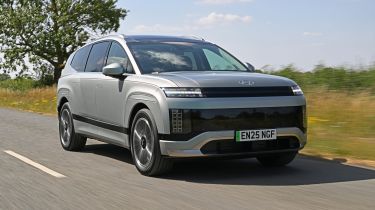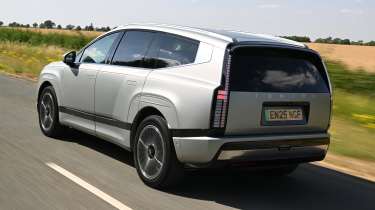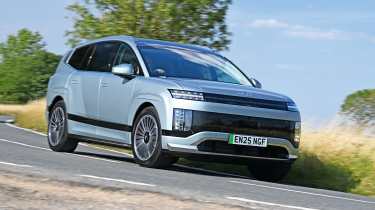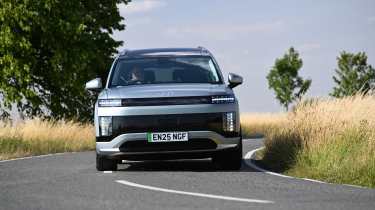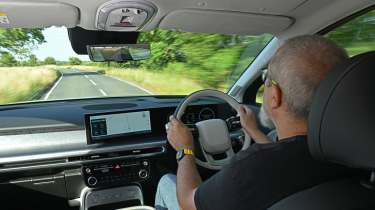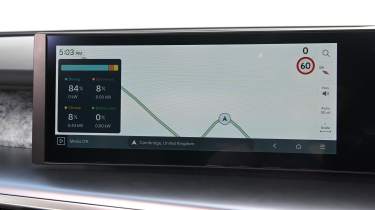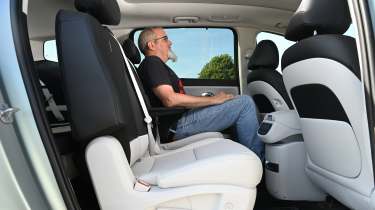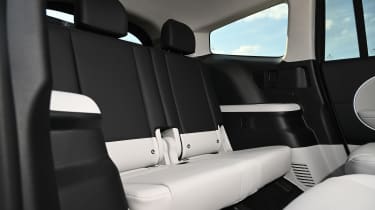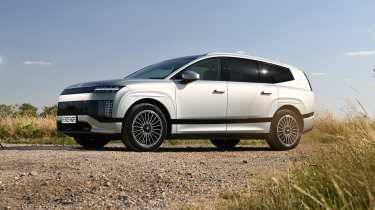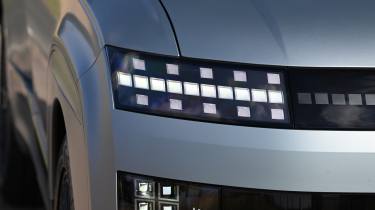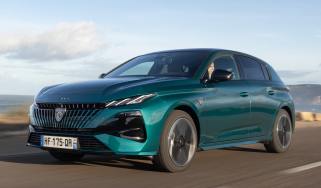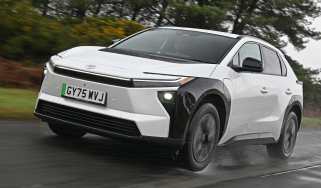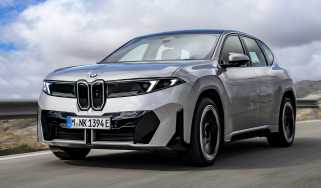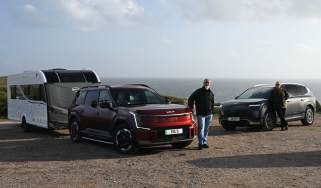Hyundai Ioniq 9 review
Enormous new battery SUV offers space and comfort for seven people

Our opinion on the Hyundai Ioniq 9
The Ioniq 9 gets most of the premium electric SUV character traits right, with a long list of kit, plush seats and plenty of passenger space. Top-spec Calligraphy trim doesn’t quite hit the mark, courtesy of an overly firm ride that takes the edge off a package that should be all about comfort, but there’s no issue with the quality inside, which arguably matches premium brand Genesis in places. The tech is user-friendly, albeit with a few irritations, and there are plenty of practical touches, too. However, there are less expensive electric SUVs on the market that deliver even higher quality at a more competitive price.
About the Hyundai Ioniq 9
The pursuit of premium is something that even the most mainstream manufacturers are engaged in these days, and the Hyundai Ioniq 9 aims to deliver the ultimate in luxury as the company’s new flagship electric SUV. It’s a seven-seater as standard, or a spacious six-seater as an option, with a big battery for a long driving range. Hyundai has piled on the standard kit to make occupants feel pampered and relaxed on every journey.
If the concept of a large Korean electric luxury SUV sounds familiar, it’s a template that has already been followed by the Kia EV9. The Ioniq 9 uses the same E-GMP platform as that car, as well as Hyundai’s other electric Ioniq models. But while the EV9 has a hard-edged element to its design, the Ioniq 9 is more sculpted, courtesy of Hyundai’s ‘Aerosthetic’ design concept.
At five metres long it’s still a vast SUV, but the rounded nose, tapering window line and narrow glass area over blistered wheelarches mean that the Ioniq 9 carries a distinctive look when compared with Kia’s biggest model. These features are combined with aerodynamic tweaks that help the Ioniq 9 return a drag coefficient of 0.259Cd when digital door mirrors are fitted (it’s 0.269Cd with standard glass mirrors). As with Hyundai’s other Ioniq models, the 9 doesn’t follow a set template, so it looks unique when compared with the Ioniq 5 and Ioniq 6, although the pixel-style lighting front and rear does offer a connection between all three models.
There are Premium, Ultimate and Calligraphy trim levels to choose from in the Ioniq 9 line-up, while all cars bar the Premium version feature four-wheel drive from a twin-motor set-up. Seven seats is the standard configuration, but the top-spec Calligraphy can be upgraded to six premium captain’s chairs with a sliding and rotating second row for £1,000 extra.
Hyundai Ioniq 9 prices and latest deals
Since it’s the flagship of the Hyundai range, the Ioniq 9 comes with a flagship price tag. The Premium model starts around £65,000, with the rest of the range priced from £73,000 to nearly £80,000. That’s a lot of cash, although through the Auto Express Buy A Car service, you can get behind the wheel for less than £600 a month.
Performance & driving experience
Pros |
|
Cons |
|
Unsurprisingly, keen handling and nippy town driving aren’t among the large Ioniq 9’s strengths. However, its comfort and refinement impress.
While upmarket brands such as Land Rover and Mercedes equip their highest-spec models with air suspension, the Ioniq 9 features a more conventional set-up with a MacPherson multi-link front end and a full multi-link set-up at the back. However, it’s also equipped with self-levelling dampers and hydroelastic bushings to enhance the smooth ride.
On the road, the soft edge to the suspension is present, although the large 21-inch wheels that come with Calligraphy trim undo some of that comfort, because they introduce a fidget to the ride where the Ioniq 9 can become quite unsettled over uneven surfaces. It’s an underlying aspect of the car that never really fades away at any speed, which is a shame because in most situations this is a vehicle that should deliver a smooth ride.
This focus on comfort comes at the expense of handling, but since the Ioniq 9 is such a big, heavy machine, it’s not a natural when it comes to hustling down a twisty B-road. The steering lacks feedback, while body roll in corners will be the biggest limiting factor as to how hard you choose to drive.
| Model | Power | 0-62mph | Top speed |
| Ioniq 9 Premium RWD | 215bhp | 9.4 seconds | 118mph |
| Ioniq 9 Ultimate AWD | 303bhp | 6.7 seconds | 124mph |
| Ioniq 9 Calligraphy AWD | 421bhp | 5.2 seconds | 124mph |
Electric motors, 0-60mph acceleration and top speed
The Ioniq 9 is available with a choice of three powertrain options. The range kicks off with a rear-wheel drive model with 215bhp and 350Nm of torque. Performance is hardly scintillating, though, and we suspect many buyers spending this much might choose to upgrade to the first of the dual-motor models. Here, outputs climb to 303bhp and 605Nm.
The top-spec model ups the ante further, with a healthy 421bhp and 700Nm. It’s smooth and strong, and even the most powerful model deploys its power cleanly and without fuss. Motor refinement is hard to fault, too.
There are four drive modes to choose from that change the throttle response. In Normal and Sport modes, there are instant reflexes that make the most powerful model’s claimed 0-62mph time seem entirely feasible. The multifunction seats lower the base and firm up the bolsters when Sport mode is chosen to create more of a sports seat that holds you in place when cornering.
However, another trait of these modes is a throttle pedal that offers responses that are slightly too sharp at the top of its travel. Small applications see the car jerk forwards as the power comes in, while lifting off to cut the power sees a similar movement in the opposite direction, and this is exacerbated by the car’s soft suspension set-up.
Town driving, visibility and parking
It’s fair to say that the Ioniq 9 doesn’t feel entirely at home in the city. It’s a large car, and the turning circle, at around 12.5 metres, is pretty big, even compared with those of other seven-seat alternatives. Slightly shorter cars such as the Peugeot E-5008 turn tighter, while some versions of the likes of the Audi Q7 have four-wheel steering to help trim its turning circle.
One of the other small gripes with the Ioniq 9 comes from the braking at low speeds. The motor regeneration is smooth for the most part, but when coming to a stop, it releases quite suddenly, which makes it difficult to bring the car to a smooth halt.
Country road driving and handling
You might hope that the Ioniq 9 would feel a bit more wieldy when you get the car out of urban areas and out onto slightly more open roads. It doesn’t.
This is a heavy car (as much as 2.7 tonnes in its dual-motor form) and it really feels every bit of that when it’s moving along a twisty road. The steering is nicely weighted but quite slow to respond, while there’s an appreciable amount of body roll through corners. Mid-corner bumps cause the car to briefly shimmy away from your desired course – another giveaway of the car’s mass.
Motorway driving and long-distance comfort
There is one area where the Ioniq 9 excels, and that’s on a motorway. The fairly soft suspension set-up that makes it feel a little lethargic on a B-road really comes into its own at higher speeds, where a long-legged, easy-going personality reveals itself. This, along with the strong refinement, make the Ioniq 9 a very comfortable place for seven to cover huge distances.
The Ioniq 9’s relatively jerky throttle isn’t too much of an issue when driving solo, but if you have passengers that are prone to motion sickness, it might be better to select Eco mode, which rounds off the response to make it smoother, while also boosting efficiency. - Dean Gibson, Senior test editor
Range, charging & running costs
Pros |
|
Cons |
|
A large battery ensures a strong range despite the Ioniq 9’s underwhelming efficiency. A good home charger is a must.
Electric range, battery life and charge time
Our efficiency figures were based on the Calligraphy model with the most powerful Performance motor. However, these results will be largely similar to those of the AWD Ultimate, which in official tests is rated with a nominal four miles more on a charge than the 372 miles of the Performance. As such, our 2.6 miles/kWh test figure, achieved with temperatures between 10-15 degrees Celsius is fairly representative for both dual-motor powertrains. It’s a number that isn’t particularly efficient, but is compensated for by the huge 110.3kWh battery, which means our real-world range worked out at 287 miles. Officially Hyundai quotes efficiency of exactly three miles per kWh.
Charging speeds are very impressive on paper, with a maximum rate of 233kW allowing that huge battery to take a 10-80 per cent top up in 24 minutes. We’d like to see the option to manually initiate battery preconditioning when heading for a fast charger, however, because this would ensure that the Ioniq 9 is best able to achieve its claimed speeds when you plug in. The fastest charge speed we recorded during our use was 157kW, although the battery was at around 50 per cent full at this point.
The ability to charge at home is very important for EV owners looking to undercut the cost of an equivalent combustion-engined SUV, however, and for those, we’d recommend ensuring your home system is capable of running an 11kW charger. That’s because that huge battery means slow charges take time; on 11kW, a full recharge takes 10 hours – just about fine for an overnight session. Hyundai does not quote a 7kW figure, but our calculations suggest it will take almost 15 hours, and 44 hours and 45 minutes on a 2.3kW charger.
| Model | Battery size | Range | Insurance group |
| Ioniq 9 Premium RWD | 110.3kWh | 385 miles | 42 |
| Ioniq 9 Ultimate AWD | 110.3kWh | 376 miles | 47 |
| Ioniq 9 Calligraphy AWD | 110.3kWh | 372 miles | 48 |
Insurance groups
Unsurprisingly, insurance groups are fairly high. The single-motor model sits in group 42 (out of 50), while the dual-motor models are rated in groups 47 and 48.
Tax
Sitting in the three per cent Benefit-in-Kind (BiK) bracket for electric vehicles makes the Ioniq 9 a very tempting seven-seat SUV choice for company car users. Despite its fairly high retail price, it means that higher-rate income taxpayers will face annual deductions of just £881 – someone running a similarly priced Audi Q7 diesel would be faced with deductions of a staggering £10,421 over the same period.
Depreciation
Used-car valuation experts CDL estimate that the Ioniq 9 line-up is set to hold on to roughly 51 per cent of its original value after three years or 36,000 miles. The entry-level single-motor model is expected to hold up the best, maintaining 52 per cent.
To get an accurate valuation on a specific model check out our free car valuation tool…
Interior, design & technology
Pros |
|
Cons |
|
The Ioniq 9’s cabin looks modern and fresh, but we’d like to see an even higher level of finish to help elevate it above the rest of the Ioniq line-up. While the exterior design is distinctly different from the Ioniq 5 and 6, only the elevated driving position really marks the flagship out. There’s a slightly curved twin-screen dashboard with a climate control panel lower down on the centre console, and these will be familiar to anyone that has driven a modern Hyundai. It’s one of the areas where we’d like to have seen a bit more flair, but it does mean it’s a pretty user-friendly interface to use.
Interior and dashboard design
The Ioniq 9’s cabin design follows the theme of the brand’s smaller all-electric counterparts. Light colours and a wide, open dash design gives the interior an airy feel.
The basic controls are efficiently laid out; a column stalk to the right of the steering wheel includes the driving controls (Drive, Neutral, Reverse and Park), and the start button. The climate controls are part physical, part touch-sensitive; big dials control the temperature for each side of the interior, while between them is a touch panel with smaller, more fiddly keys for the rest of the functions.
Materials and build quality
The overall level of quality in the Ioniq 9 is roughly to the standard that we’ve come to expect from Hyundai, but when top-spec models are approaching £80,000, it doesn’t quite cut it as being premium when compared with other cars at this price point. Take the pop-out exterior door handles, for example; while they slide out gracefully as the doors unlock, they wobble around quite noticeably as the door is closed.
Inside, the top-spec Calligraphy models feature a decorated trim piece on the passenger side of the dash, but the finish feels hard and looks like unconvincing fake marble. The rest of the kit list is extensive, though, with heated and ventilated seats front and rear, a 14-speaker Bose sound system, panoramic glass, Nappa leather upholstery and a special storage compartment at the bottom of the centre console that uses UV rays to sanitise small items such as phones and keys.
Infotainment, sat-nav and stereo
Simply by separating the climate controls from the main touchscreen, the Ioniq 9’s system feels a little easier to use than some systems that are completely reliant on a touchscreen. It’s relatively quick to respond, too, although when compared with many other systems, Hyundai’s is slipping down the rankings. Loading times are pretty underwhelming, and setting the driver-assistance systems to your liking is a fiddly process that involves opening a sub-menu via the digital driver’s display.
The Ioniq 9 is capable of taking on a fast charge when you find public chargers quick enough, but it’s also able to top up smaller devices at a rapid rate, too. There are no fewer than seven USB-C chargers on board, catering for passengers in all three rows. These can operate at up to an impressively rapid 100 Watts, although you’ll need a thicker charging cable to take full advantage of this.
There’s also a wireless smartphone charger on the centre console. While it has a rubber pad to improve grip between phone and charger, it’s fairly small, so even during normal acceleration, braking and cornering, we found that our phone would move around enough that it would stop charging until it was repositioned.
Another carryover from Ioniqs 5 and 6 is vehicle-to-load capability, so that you can power accessories from the car’s drive battery or even send power back to the grid.
As with several other Hyundai EVs, the Ioniq 9 is available with digital side mirrors as a £1,000 option, and they replace the traditional mirrors with cameras mounted on stalks. While Hyundai’s tech works better than some of the other types we’ve tried, we don’t see enough benefit to stump up the extra cash – especially since they still sit proud enough from the bodywork for them to be susceptible to knocks. The digital rear-view mirror comes in handy when the back two rows of seats are loaded with occupants, though. - Alex Ingram, Chief reviewer
Boot space & practicality
Pros |
|
Cons |
|
At more than five metres long, and almost 1.8 metres tall, the Ioniq 9 is vast on the outside, but as long as you have the space to park it, occupants inside reap the benefits with acres of room to stretch into.
Dimensions and size
| Dimensions comparison | |||
| Model | Hyundai Ioniq 9 | Kia EV9 | Peugeot e-5008 |
| Length | 5,060mm | 5,010mm | 4,791mm |
| Width | 1,980mm | 1,980mm | 1,895mm |
| Height | 1,790mm | 1,755mm | 1,694mm |
| Wheelbase | 3,130mm | 3,100mm | 2,901mm |
| Boot space | 338-2,419 litres | 333-2,318 litres | 259-1,815 litres |
As you’d expect, the Ioniq 9 and Kia EV9 are similar in size, and take Hyundai/Kia’s E-GMP electric car platform to its maximum size. A five-metre length is the same as a Range Rover, and the Ioniq 9 is larger overall than most other seven-seat SUVs.
Seats & passenger space
The Ioniq 9’s tall body allows the driver to have a commanding view of the road ahead. The driving position is high, but while the square, near-horizontal bonnet makes it easy to see where the car ends, it also creates quite a blind spot ahead of the car. Fortunately 360-degree cameras are available, so it’s still possible to squeeze into tight spots. The steering wheel itself is very large, which can make it feel a little clumsy to use at times
Storage is generous. The large sliding centre console has a deep space inside, which can be partitioned off into smaller sections for holding a larger variety of items. This area can be accessed by a lid which is hinged both front and rear (allowing both front and middle-row occupants easy access), while a larger drawer-type entrance is also available at the back.
In the rear, the middle row is vast. The seats can slide forward and back, and even when they’re moved as far forwards as they’ll go, kneeroom is still better than in a Hyundai Tucson. Slide them to the back and there are limo-levels of leg space. Headroom is also fantastic, and whether the seats are in six or seven-seat configurations, they are comfortable.
The six-seat configuration is exclusive to top-spec Calligraphy trim and adds captain’s chairs to the middle row that can rotate through 180 degrees to create an executive-style lounge, where passengers in the back sit face-to-face. There’s also the ability to turn them 90 degrees to face the wide-opening rear doors, so fitting child seats is a doddle. In the unlikely event you’re raising two pairs of twins at the same time, then it’ll be a safe choice thanks to the fitment of four Isofix child seat-mounting points.
Unlike in many seven-seaters, those in the very back are almost as well catered for as those in the row ahead. Kneeroom is a little tighter but still more than good enough for all but the tallest adults, while headroom comes close to matching the middle row. Each back-seat passenger gets their own cup-holder, too.
Boot space
Even in seven-seat mode, the Ioniq 9’s boot is reasonable. At 338 litres, it offers five litres more space than the Kia EV9, and 28 litres more than the Volvo EX90. Drop down the back row (made easy by electrical switches in the boot) and that figure climbs to 908 litres. In two-seat mode the space stands at an enormous 2,419 litres.
One issue we did find is that the powered tailgate opens to reveal a surprisingly small opening – a side effect of the tapered shape of the car’s bodywork – which will make loading large items trickier than you might expect.
Adding to that already cavernous boot is a 52-litre storage space under the bonnet (it’s 88 litres in the RWD model). In a car where there are likely to be passengers and stuff in the way of the rear underfloor storage, having a different spot to hold the charging cables is a useful feature.
Towing
At 2,500kg, the braked trailer limit of the Hyundai is plenty for the average caravanner, although beware that the range will take a hit. From experience you can expect the car’s estimated range to halve when a trailer is hitched.
After we subjected the Ioniq 9’s sister vehicle, the Kia EV9, to a towing test in September 2025, we discovered that a smooth, powerful EV powertrain is ideal for a big trailer – even if public chargers don’t do a great job of accommodating cars with trailers. - Alex Ingram, Chief reviewer
Reliability & safety
Pros |
|
Cons |
|
Underwhelming. A finish of 20th place overall put the Korean brand in the bottom half of the table, a couple of places behind sister company Kia.
There’s no faulting the Ioniq 9’s safety credentials, though. A five-star Euro NCAP performance is backed up by loads of standard assistance tech; all models get the brand’s Highway Drive Assist 2.0, which can autonomously hold the car within its lane on a motorway for short periods, as standard. Other kit includes automatic lane changing and Hyundai’s familiar rear-facing lane-change cameras, too.
In fact, the Ioniq 9 follows a path that every new Hyundai has taken, with a number of beeps and bongs from the assorted safety systems to keep you on the road. The over-speed warning can be silenced via a long press of the mute button on the steering wheel, but harder to deactivate is the distracted driving warning. A small sensor on top of the steering column detects when your eyes are not on the road, but much like other Hyundai’s we’ve tried with this system, it’s hyper sensitive, and will even alert you if you're looking across a T-junction or at the main touchscreen, for example. It’s quite frustrating.
The Ioniq 9 is cheaper to service than a similarly sized petrol or diesel car. That’s reflected in the service plan: it’s just over £300 for three years’ worth of maintenance.
| Euro NCAP safety ratings | |
| Euro NCAP safety rating | Five stars (2025) |
| Adult occupant protection | 84 per cent |
| Child occupant protection | 87 per cent |
| Vulnerable road user protection | 77 per cent |
| Safety assist | 83 per cent |
Buying and owning
- Best buy: Hyundai Ioniq 9 Premium
We’d stick with the entry point to the Ioniq 9 line-up. It’s still well equipped, costs less than the rest of the range and has the longest range, too.
Hyundai Ioniq 9 alternatives
The obvious alternative is the Kia EV9 that uses the same platform, but has a smaller battery, at 99.8kWh. That means its overall range is shorter, but it’s more expensive to buy than the Hyundai. Elsewhere, the Volvo EX90 offers seven spacious seats and all-electric drive, while the Peugeot E-5008 is slightly smaller, so the rearmost seats are better suited to occasional use, but has a higher-quality cabin than the Ioniq 9.
Frequently Asked Questions
It’s OK, but not amazing. It has lots of space, but for the price it lacks a premium feel to elevate it above the rest of Hyundai’s Ioniq models. We wish it felt a bit classier inside to help justify the price.
Deals on Hyundai Ioniq 9 and alternatives
